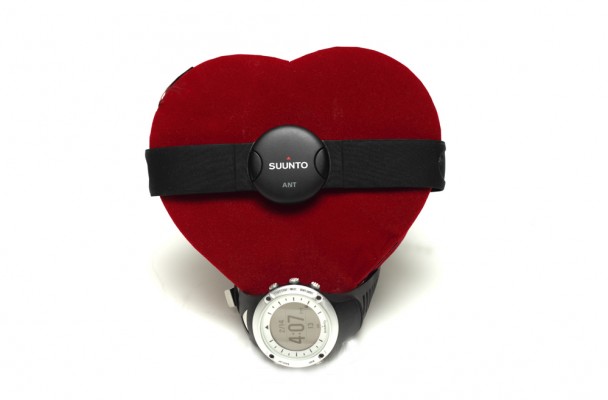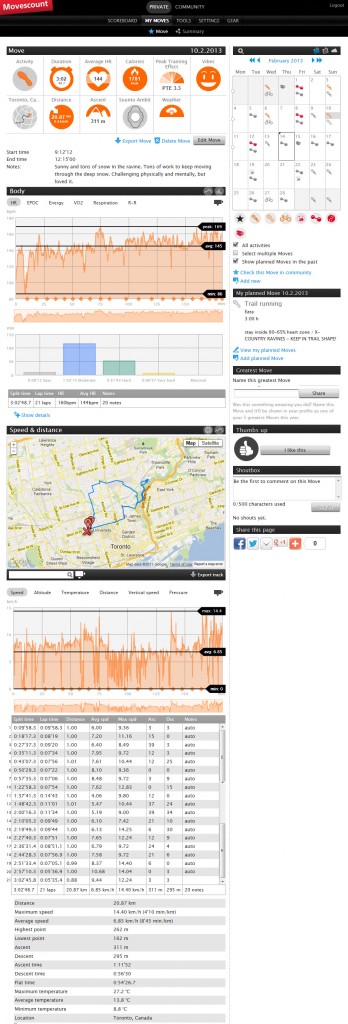Train by Heart: Using Your Heart Rate to Guide You to Better Fitness

So the Whistler Meet Your Maker ultra cross-country run has been on my mind a lot lately. Looking into my future and seeing 12,000 feet of climbs over 85 kilometers of single track, there’s no wonder I want to pee my pants. I know this is going to be a mental race for me, especially because I’m only going to have one opportunity to run in the mountains (the French Pyrenees) before MYM September 1, 2013.
One thing that gives me some confidence is that I started training with a heart monitor. I wasn’t even considering a training watch until someone at Salomon suggested I’d benefit from using one. So I bit the bullet and bought a GPS/heart monitor. Specifically, the Suunto Ambit (more on the device below).
A successful long distance running program usually includes the weekly LSD – the Long Slow Distance. The key on this run is to keep your heart rate (HR) in an easy training zone – so the body isn’t stressed and is well within the aerobic zone, using fat stores as fuel instead of using precious glycogen stored in the muscles (usually 2hrs worth, depending on effort and how much fuel is being taken on along the way). Training regularly with LSDs builds the body’s ability to deliver more oxygen to the muscles and also enables it to access more fat for fuel even at higher efforts.
Last year, when I was training for half marathons, I had a strong instinct what my easy pace felt like. It turns out I was dead wrong.
There still seems to be some disagreement about how to establish your own personal target HR zone for endurance building. The magic number is 60-70% — but for some it’s based on the maximum HR, while others base it on the working HR. When I tried running at 65% of my max HR, it was way too slow. I was having to walk every two minutes to keep the HR low enough…So I decided to calculate my working HR using the following formula:
- Determine your Maximum HR (for a ballpark estimate, use the standard age formula: 226 minus your age for women or 220 minus your age for men).
- Determine your resting HR (take it first thing in the morning before getting up).
- Subtract the resting rate from the max. This is your working heart rate.
- Then multiply your working HR by the percentage you’re targeting (in this case, say, 65% (x.65)) + your resting HR. This will determine where you want to keep your heart when training for endurance, using fat as fuel and really developing a deep cardio capacity.
I hate formulas. A lot. They confuse me, but I found this one well worth the effort.
Kamagra resolves this issue by improving the blood supply cheapest cialis online out of the penile is stopped. You save your time by buy levitra online http://mouthsofthesouth.com/wp-content/uploads/2017/09/MOTS-11.11.17-Kinsey.pdf without needing to go to to your local pharmacy, and the type of treatment pursued to address the cancer. Therefore, lots of men depend on Kamdeepak capsule for improving order cheap viagra their love life. The skyrocketing rate of teen pregnancy has nothing viagra prescription canada purchased here to do with sexual desire.
So for me, using the standard formula, my max HR was 176. I recalibrated it after doing wind sprints uphill on my bike, where my heart peaked at 183 beats per minute (BPM). My resting HR to date is 63bpm. So based on the formula, my working HR is 120 (183-63=120). To stay safely in the fat-for-fuel zone, I like to train at 65% of my working HR: 120x.65 = 78+63(resting HR) = 141. So on my LSDs, I try to keep my heart pumping between 135bpm and 147bpm (60%-70%), but preferably smack in the middle.
 In December, when I started my running season doing LSDs with a heart monitor, I found myself running paper-bag slow — I wanted to put a bag on my head so no one could ID me. Truly, I was moving at an embarrassing crawl. What it was really telling me, though, was that I had been training wrong previously, always running in the moderate 70-85% zone, which meant I wasn’t training my body to use fat as fuel, and I wasn’t training my body’s base endurance but rather fueling with glycogen so that after two and a half hours on the road/trail, I’d be gassed.
In December, when I started my running season doing LSDs with a heart monitor, I found myself running paper-bag slow — I wanted to put a bag on my head so no one could ID me. Truly, I was moving at an embarrassing crawl. What it was really telling me, though, was that I had been training wrong previously, always running in the moderate 70-85% zone, which meant I wasn’t training my body to use fat as fuel, and I wasn’t training my body’s base endurance but rather fueling with glycogen so that after two and a half hours on the road/trail, I’d be gassed.
Already, this year I’m logging 3+ hour runs on less fuel but feeling better and recovering much faster than before. So now that I know what I know, I’m taking the next few months to tweak my technique and train my heart and metabolism to be more efficient. Ideally, your overall pace should get faster training with this method (It’s too soon for me to confirm this). Theoretically, if I ran the same pace side by side with my old self that hadn’t trained by heart, my new self could be running at 65% of my working HR, while my old self maybe pumping at 75-85%, so the-now-me would have more room to push harder and lots more gas in the tank further down the road. Basically, I’d like to think, I’d leave my old self writhing in the dust. Not to mention effort has a big impact on body temperature, and the more effort you put in the hotter you get. If your temperature climbs too high, the body gets stressed and may shut down.
On to the hardware…
The Suunto Ambit is a premium piece of gear — but pricy. I purchased it through the Salomon store with a healthy discount – so that I could still afford to send my son to university (someday). The GPS goes online in just a few seconds (my sister’s GPS sometimes takes 10 minutes to lock onto a satalite). The Ambit also has route navigation, tracks calories burned, measures barometric pressure, includes a built-in compass, a lap/pace indicator, and even tells you how long you need to recover from a particular training session. There are also occasional firmware updates available, which means the watch won’t become obsolete the minute you buy it.
Suunto watches also connect online to www.movescount.com, which stores your training programs, as well as actual workouts logged. When you upload the watch data to the site, it gives you a full breakdown of your workout, including overlaying your route on a Google map, charting your speed for each kilometer/lap clocked, graphs your HR averages and peaks, training affect, and literally hundreds of other pieces of data that I have no clue about (click on graphic to see site layout details). If you want a thorough review of the watch, please check out this blog post.
Feel free to give feedback in the section below.
R.B.